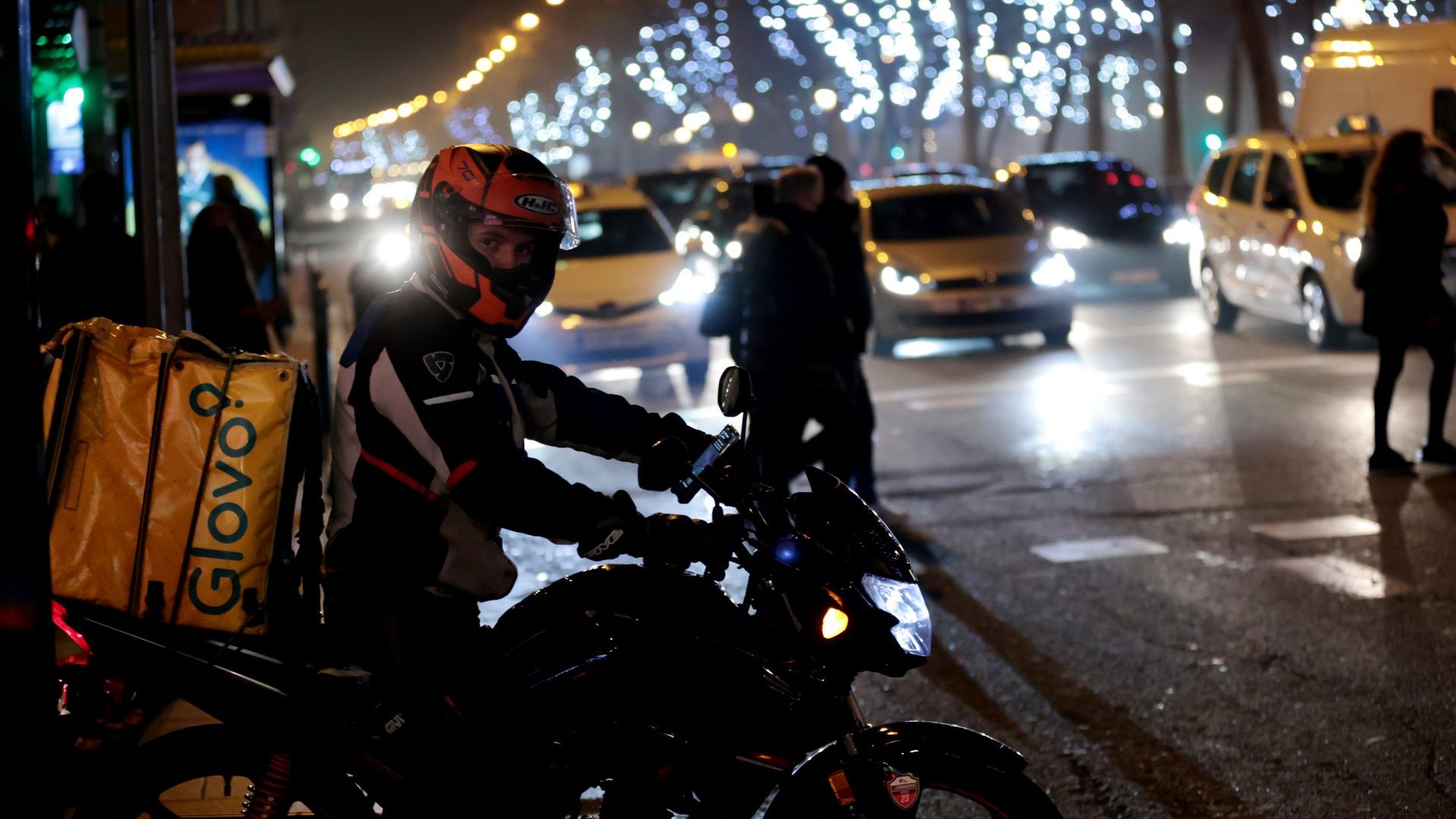If you live in a major city in the UK, chances are that, within a 10-minute drive of your home, there is at least one dark store, and that you are completely unaware of it.
A dark store is by its very nature unobtrusive. Because these aren’t stores in the traditional sense – they aren’t designed for walk-in customers and board up their windows. Rather they exist solely to serve so-called rapid grocery brands such as Getir, Gorillas, Gopuff, Zapp and Jiffy, who promise to get your delivery to you by bike or moped in anything between 10 and 20 minutes and which, at the last count, operated from around 200 dark stores in the UK, including in London, Birmingham, Manchester and Cardiff.
Often these stores are in residential streets. In London in particular they can be found in railway arches, where sky-rocketing rents in recent years have driven out traditional businesses. And they are undoubtedly convenient – Turkish-based Getir, the German Gorillas and London-based Weezy aim to get your goods to you within 10 minutes, while Jiffy, also based in London, says five to 20. Some set a minimum order while others will deliver a single bag of coriander for your curry if you’re willing to pay a delivery fee. Those delivery fees are usually around £2-£3, or free if the order’s over £25 or £30.
Is this, then, the future of our shopping – at least in the big cities? Is the traditional corner shop the next to meet its demise in technology’s onward march? Or are the rapid grocery firms, which first emerged as the world locked down, the next dotcom bubble, with just too many running at a loss too quickly? Views within business are mixed.
“In my opinion, it won’t be a revolution but could be another component within a complex market,” Tim Reay, head of grocery at IT service management company Wunderman Thompson Commerce says.
“It does provide an opportunity for smaller retailers to take a foothold. Still, supermarkets online and offline need to be exceptionally cautious to ensure they build a viable business model.”
Seb Robert, founder of same-day delivery business Gophr, tells me: “Nobody has ever complained that their delivery got to them too fast, and that ‘need for speed’ isn’t going anywhere. That said, there may be too many dark stores out there right now for the level of demand.
“The grocery space is not associated with high margins, and when you consider the additional costs involved in rapid grocery delivery (RGD), it’s incredibly difficult to be competitive. You need to deliver to the dark store, usually in densely populated areas where property prices are at a premium, then pick, pack, and deliver to the customer all within 15 minutes. That’s a big chunk of resources.
“It’s also not terribly sustainable either. Some RGD players are buying stock from supermarkets to top up their own stock – fragmenting the already creaking supply chain further. It makes a lot more sense to continue to deliver to existing supermarkets and use those as dark stores moving forward. Another potential option would be to operate out of very large-scale dark stores that can service a huge volume of orders and merge them into routes. But you’re then compromising on speed of delivery.
“We’re probably going to see more of a holding pattern and it’s unlikely a lot of the current RGD startups will survive, inevitably leading to consolidation. We saw something similar in the restaurant delivery space between 2014 and 2018. Those who raised the biggest rounds survived. A lot of them still aren’t profitable, mind.”
And the consequences for small retailers and the traditional corner shop?
“We’re likely to see a small reduction overall but I don’t think it’s going to be the bloodbath some have predicted,” Robert says. “Restaurants moved into delivery pretty smoothly and there will be a similar transition within the corner shop space.”
Entrepreneur Neil Debenham also told me it remained to be seen whether these companies would continue to boom post-pandemic, particularly in their current form.
“While appetite from consumers will likely remain high as more and more are focused on instant accessibility, the companies are set to face increased regulation – both Amsterdam and Rotterdam have imposed a one-year ban on new dark stores opening,” he says.
And it is the Netherlands where a backlash against the rise of the dark stores has started. In total six Dutch cities are either preparing to or have already introduced strict new regulations against the firms.
“The business model of these companies is that they want to deliver groceries in 10 minutes. That means they need to be based in neighbourhoods. That’s exactly the place where they also cause nuisance,” Amsterdam’s deputy mayor, Marieke van Doorninck, told Reuters.
The complaint is that, as described above, the firms operate by taking what were in most cases existing shopfronts and transforming them into aesthetically unpleasing mini-warehouses with boarded- or taped-up windows (much like betting shops in the UK until relatively recently – Conservative home secretary Rab Butler, who first allowed them at all, noted that politicians were “so intent on making betting shops as sad as possible, in order not to deprave the young, that they ended up more like undertakers’ premises”).
Modern Dutch politicians take the opposite view – that their cities’ buildings should not look as sad as possible. The Hague, Groningen, Arnhem and Amstelveen are, like the Netherlands’ two biggest cities, looking into banning new dark stores in certain districts where most of the complaints come from. One company, the Berlin-based Flink, has threatened to sue over a breach of EU law, claiming the cities’ “restrictions on the freedom of services must meet the conditions of non-discrimination, necessity, and proportionality, which they do not in our opinion”.
Further afield, the rise of dark stores is causing consternation. In the US a recent article in the Stanford Social Innovation Review said: “Left unchecked, the spice, charm, and hustle and bustle that define cities will cease to exist. Dark retail means that our neighbourhoods will go dark too. That means no shopkeepers, no patrons, fewer people, and less activity on the streets – a scary pathway to neighbourhood blight and higher crime.”
Such concerns are not rare. In my part of east London, for example, a street of railway arches close by has, relatively recently, become home to dark stores for Weezy and Zapp as well as so-called “dark kitchens” (essentially the same, but for takeaway deliveries) for Wagamama and Patty & Bun, the burger chain, as the rise in rents that followed Network Rail’s sell-off of the nation’s arches in 2018 bite for traditional businesses. These businesses had shop frontages and meeting places, and some locals fear the area will become less safe if it’s just mopeds and shutters.
Yet for all the aesthetic concerns of politicians, and safety fears of locals, it looks as if the greatest danger for the rapid grocery firms is the rapid grocery firms themselves. There is a huge number, particularly in London, none are close to turning a profit and all are burning through investors’ cash with heavy outdoor advertising and sign-up offers. (More positively, many also cost themselves more by directly employing staff and providing them with vehicles, unlike many courier firms). Are these firms sustainable?
“Like many businesses that formed during the lockdown bubble, many of these startups were built upon the new backdrop of consumer demand created by the pandemic with a focus on short-term success without a long-term plan,” says Debenham.
“Given this, only a few of the current wave of on-demand grocery startups will be able to transition successfully to the changing market and survive, and we have already seen Getir acquiring competitors such as Weezy.
“Given the wealth of startups in the field, such as Gorillas, Zapp and Getir, it has become hard for them to generate brand loyalty and showcase a unique selling point. With many focusing on discounts and deals to acquire customers, users go from one brand to the next cashing in on the discounts.”
Linda Ellett, head of consumer markets, retail and leisure for KPMG UK, said that currently such firms were “not profitable, and it’s very much a race to scale and retain a customer base”.
“Players are doing this through introductory offers, promotions and discounts – which eats into profitability,” she says.
“Delivery charges in the UK are also currently lower than in other more established rapid delivery markets. The road to profitability is likely to be a long one, with operators either selling up to larger grocery players or being one of a handful of larger operators that survive the inevitable consolidation.”
“From a business sustainability perspective clearly this will be influenced by the backing each operator has in the short term and the ability to fund operating losses. But to become profitable, these rapid delivery businesses will need to build a customer base of scale that is willing to purchase regularly, pay delivery fees, and increase the basket size, over time to a point where it is economically viable.”
The basket size is a problem – literally. I spoke to George Phillips, commercial director at east London-based independent retailer supplier Wanis, which specialises in world food products.
“They’re very limited as to what they can carry, as most of them use bikes and scooters for delivery,” he tells me. “Those, for us, we see absolutely as top-up. People don’t do their grocery shopping at Getir. They’ll do a shop, but it’ll be things that they need in a hurry. One of the things we found from working with them is their throughput is limited by the fact that the guy on the bike can only carry about 30kg and, actually, when you’ve got tin cans and bottles in there, that’s not a lot.”
In the big cities, he points out, many corner shops have extensive selections of world foods, which none of the rapid grocery firms carry, except the likes of coconut milk – something he thinks will work in their favour.
Similarly, Wayne Snyder, vice-president for retail industry strategy EMEA at consultants Blue Yonder, was optimistic about the future for small stores in the face of digital competition.
“Pre-pandemic, much of the growth in the grocery market came in the convenience market with consumers shopping little and often,” he says. “The pandemic saw the return of the weekly shop but as we look into the future, maybe once energy prices calm down, convenience may well dominate again and the ability to top up every day may well prove the way many choose to shop.”
Rebecca Crook, chief growth officer at digital product agency Somo, even sees some opportunities.
“Many consumers are keen to support local suppliers and grocers, so there is an opportunity for local shops to join forces and offer something compelling to their communities that grocery giants can’t do,” she says.
“There is a gap in the market for businesses to offer customers the opportunity to purchase a local craft beer or a locally made jam with their weekly shop, which would appeal to a lot of people who want their shopping quickly but also want to support their community. There are also other opportunities for niche operators to target specific consumer needs. For example, UK holiday hotspots like the Lake District or Cornwall host thousands of holiday lets – many self-catering – where having on-demand, local produce delivered makes sense. Why go to Tesco when you can access amazing local produce to your door quickly?”
Finally, Daniel Hulme, CEO of AI tech firm Satalia, tells me: “As the market becomes increasingly crowded, there is a risk that the dark store model will become commoditised and teeter on unsustainability – and it’s the customers that will suffer because they will see a rise in prices. This could drive consumers back to the high street, with lower prices and enhanced ‘in-store experiences’ that make the trip worthwhile.”
And maybe that is the danger for these firms. That for all the threats to these firms of legislation halting their rise, maybe the problem could be a combination of a bursting bubble and the fact that, after a two-year period of sitting at home, existing on deliveries, people just want “experiences” again – even if we can get a bag of coriander to our door at 10 minutes’ notice.












